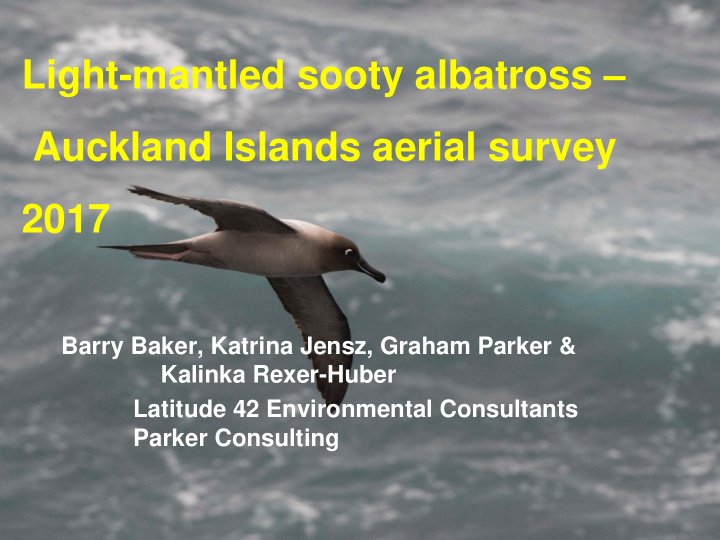



Light-mantled sooty albatross – Auckland Islands aerial survey 2017 Barry Baker, Katrina Jensz, Graham Parker & Kalinka Rexer-Huber Latitude 42 Environmental Consultants Parker Consulting
LMSA background ― Poorly studied, circumpolar distribution ― nest solitarily or in small colonies, nesting along cliff edges in remote locations ― monitoring challenging, with few accurate population estimates ― global popn 21,600 pairs Auckland Is 5,000 pairs – 25% ― ACAP species of interest 2
background ― Auckland Islands LMSA known to breed on Adams, Disappointment, Auckland, Enderby, Rose Islands ― no detailed breeding studies undertaken in Aucklands but breeding phenology appears similar to other sites: - adults return to mid-September / early October - lay eggs in late October / early November - hatch late December / early January - chicks brooded for 19-21 days, fledge 140-157 days 3
project aims • 1. Assess efficacy of aerial photographic survey work on LMSAs at Adams Is January 2017. • 2. Provide recommendations regarding potential for aerial survey methods for monitoring population trends. 4
5
methods • Aerial survey undertaken 18 January 2017 1600 hrs • early-late brood guard • single-engine Squirrel AS350B3 • LMSA study site at Adams Island overflown & photographed using high definition DSLR cameras • All nesting sites subsequently identified from analysis of photos • Aerial counts compared with ground counts s6
aerial photography protocol ― photos taken at 700 ft & 1000 ft asl ― photos taken as raw files, converted to fine-scale jpeg ― Nikon cameras & lenses: 70 – 200 mm zoom 300 mm telephoto ― photos assessed using Adobe Photoshop ― paintbrush tool used to mark off counted birds ― each bird assumed to represent a breeding pair. 7
results ― although LMSAs are dark birds, generally nesting against dark substrates, the light mantle provides contrast with backgrounds ― Photos were of high quality and birds were easily located ― little difference in counts taken at 700 & 1000 ft asl 8
9
results ― Ground counts showed 42 active nests in study site ― Aerial counts identified 48 Apparently Occupied Sites ― Detectability: 2 active nests were not visible 40 active visible; so 5% should be added to an aerial count to account for detectability 10
results ― Apparently Occupied Sites – non-breeding birds: Ground counts showed that 8 of 48 AOSs in aerial photos were not active nests i.e. loafers or non- breeders in photo ― correction factor for loafers = 19.2%, subtract from number of Apparently Occupied Sites 11
feasibility 1. aerial survey using helicopters is an effective method for counting LMSAs on Adams Island 2. probably the most cost-effective technique for rapidly assessing population status in this area 3. expanding from existing site to other areas on Adams Is could be explored. 4. We recommend further sites be added as time and resources permit, such that in each year c.300 nesting pairs are monitored 5. Estimated cost helicopter on site: 1 hours max analysis & report preparation: 2 days 6. Development of annual correction factors useful 12
Acknowledgements Aircraft: Southern Lakes Helicopters, Mark Hayes DOC: Katie Clemens-Seely Igor Debski 13
Recommend
More recommend